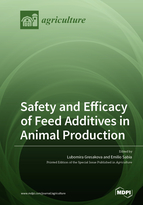Safety and Efficacy of Feed Additives in Animal Production
A special issue of Agriculture (ISSN 2077-0472). This special issue belongs to the section "Farm Animal Production".
Deadline for manuscript submissions: closed (20 February 2022) | Viewed by 53935
Special Issue Editors
Interests: trace elements; mineral status; antioxidant status; absorption; bioavailability
Special Issue Information
Dear Colleagues,
Due to the challenge of reducing the environmental impact of animal production as well as maintaining animal health and sustainable livestock productivity, it is necessary to change the feeding strategy of livestock. Feed supplementation with safe and efficient nutrient additives should provide optimal animal performance as well as maximize livestock productivity with respect to the environment. Nutritional feed additives used in animal nutrition and originating from different sources affect physiological processes, such as nutrient digestibility and absorption, immunity, mineral status, antioxidant activity or reproduction of livestock. Improving nutrient digestion and absorption by feed supplementation can increase micronutrient bioavailability, provide safe and functional foods, as well as reduce environmental pollution from animal production.
The scope of the present Special Issue is to publish high-quality papers concerning various sources of nutritional feed additives using in-farm animal nutrition, and to investigate their effects on livestock health and production together with environmental pollution. Therefore, we invite you to submit, in this Special Issue, your recent findings, in the form of original research, communications or reviews regarding feed supplementation with nutritional feed additives, nutraceuticals or alternative feed byproducts, the effect of feed supplementation on animal growth, health and production, gut microbiota and food safety, and environmental impact.
Dr. Lubomira Gresakova
Dr. Emilio Sabia
Guest Editors
Manuscript Submission Information
Manuscripts should be submitted online at www.mdpi.com by registering and logging in to this website. Once you are registered, click here to go to the submission form. Manuscripts can be submitted until the deadline. All submissions that pass pre-check are peer-reviewed. Accepted papers will be published continuously in the journal (as soon as accepted) and will be listed together on the special issue website. Research articles, review articles as well as short communications are invited. For planned papers, a title and short abstract (about 100 words) can be sent to the Editorial Office for announcement on this website.
Submitted manuscripts should not have been published previously, nor be under consideration for publication elsewhere (except conference proceedings papers). All manuscripts are thoroughly refereed through a single-blind peer-review process. A guide for authors and other relevant information for submission of manuscripts is available on the Instructions for Authors page. Agriculture is an international peer-reviewed open access monthly journal published by MDPI.
Please visit the Instructions for Authors page before submitting a manuscript. The Article Processing Charge (APC) for publication in this open access journal is 2600 CHF (Swiss Francs). Submitted papers should be well formatted and use good English. Authors may use MDPI's English editing service prior to publication or during author revisions.
Keywords
- nutritional feed additives
- digestibility
- bioavailability
- microbiota
- food safety
- environment






